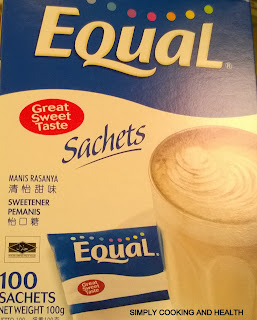Sugar is a natural sweetener. It is the least harmful of all sweeteners. It has high calories and therefore not suitable for diabetics and obese people. Only these two groups of people seek the use of artificial sweeteners.
 |
| In powder form |
All synthetic sweeteners have some bad side effects.
 |
| Sweetener in tablet form |
Splenda (sucralose) is made in the laboratory by combining three atoms of sugar with three atoms of chlorine. Splenda is the newest in the family of artificial sweeteners that is touted to be better than all its predecessors such as saccharin, aspartame and acesulfame potassium. Splenda is by far the most popular artificial sweetener. Since its approval by FDA in 1999, it holds a 62% market share in a $ 1.5 billion artificial sweetener market. It has energy content of 3.36 kilo calories per serving of 1 gram packet. Under FDA regulations, a product containing less than 5 calories can be called zero calorie product. Thus splenda is advertised as a zero calorie product.
It is considered consumption 9 mg/kg/day is within safe limits. A person weighing 70 kg can consume 0.6g of splenda per day.
Splenda has been in the market for 16 years now. If it has any serious problem it would have come to light by now.
The web site www.truthaboutsplenda.com lists a variety of consumer complaints from Sucralose (Splenda) consumption, such as: gastrointestinal problems, migraines, seizures, dizziness, blurred vision, allergic reactions, blood sugar increases and weight gain.
A recent animal study in Italy links splenda with leukemia. We do not know how relevant is this study (conducted on mice ) to humans.
Aspartame
Aspartame is an artificial, non-saccharide sweetener used as a sugar substitute in some foods and beverages. It is sold under the brand name NutraSweet® and Equal®.
U.S. Food and Drug Administration (FDA) approved aspartame 1981. The European Food Safety Authority concluded in its 2013 re-evaluation that aspartame and its breakdown products are safe for human consumption at current levels of exposure.
Initially, FDA approved aspartame for use in dry goods only. In 1983, the FDA further approved aspartame for use in carbonated and other beverages, and for use in baked goods, and confections in 1993. In 1996, the FDA removed all restrictions from aspartame, allowing it to be used in all foods. Aspartame has been the subject of several controversies, hoaxes and health scares.
Aspartame contains phenylalanine, it must be avoided by people with the genetic condition phenylketonuria (PKU). Among the side effects that have been linked to aspartame use are migraines, regular headaches, dizziness, diarrhea, mood swings, and memory loss.
PepsiCo announced last week (April 2015) that it's replacing the aspartame in Diet Pepsi with sucralose, the sweetener marketed under the brand name Splenda. The change is more due to consumers' reason, rather than a scientific one.
Acceptable daily intake (ADI) of aspartame for adult weighing 75 kilograms (about 165 pounds) is 3.75 grams. A 12 ounce can of diet soda usually contains about 192 milligrams of aspartame and a packet of the tabletop sweetener contains about 35mg.
Most studies in people have not found that aspartame use is linked to an increased risk of cancer.
The Food and Drug Administration (FDA) and the European Food Safety Authority (EFSA) did not find any possible link between aspartame and cancer.
Aspartame is the sweetener used in Diet Coke while Coke Zero uses Aspartame and acesulfame potassium.
Saccharin
In the early 1970s, studies in laboratory rats linked saccharin with the development of bladder cancer. For this reason, Congress mandated that further studies of saccharin be performed and required that all food containing saccharin bear the following warning label: “Use of this product may be hazardous to your health. This product contains saccharin, which has been determined to cause cancer in laboratory animals.”
Later research showed that the bladder tumors seen in rats are due to a mechanism not relevant to humans and that there was no clear evidence that saccharin caused cancer in humans, As a result the requirement of a warning label was removed in December 2000.
The use of saccharin had not become widespread until sugar shortages during World War I. Its popularity further increased during the 1960s and 1970s among dieters, since saccharin is a calorie-free sweetener. Currently saccharin is allowed in most countries.
But according to a new study presented in March 2015 at the 249th National Meeting & Exposition of the American Chemical Society, saccharin could actually be useful in developing treatments for aggressive cancers by deactivating a protein found to facilitate the spread of cancer.
Acesulfame potassium and Neotame
Acesulfame potassium (also known as ACK, Sweet One®, and Sunett®) was approved by the FDA in 1988 for use in specific food and beverage categories, and was later approved as a general purpose sweetener (except in meat and poultry) in 2002.
Neotame, which is similar to aspartame, was approved by the FDA as a general purpose sweetener (except in meat and poultry) in 2002.
Cyclamate
FDA banned the use of cyclamate in 1969. In subsequent studies scientists concluded that cyclamate was not a carcinogen or a co-carcinogen (a substance that enhances the effect of a cancer-causing substance). A food additive petition was filed with the FDA for the reapproval of cyclamate, but this petition is currently being held in abeyance (not actively being considered). The FDA’s concerns about cyclamate are not cancer related.
No comments:
Post a Comment